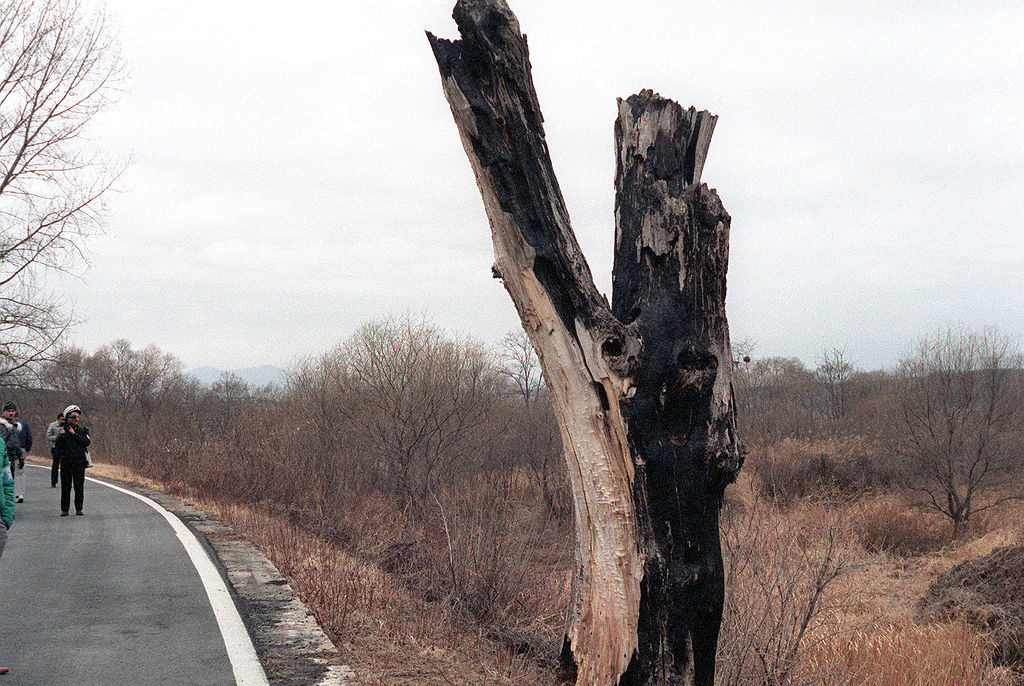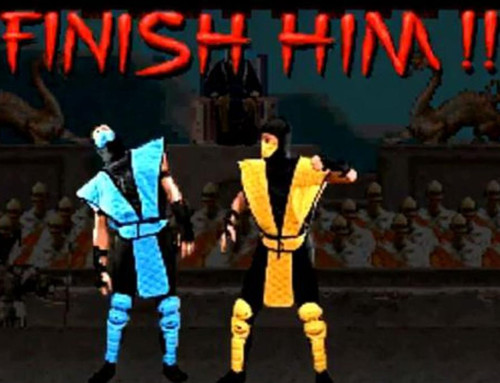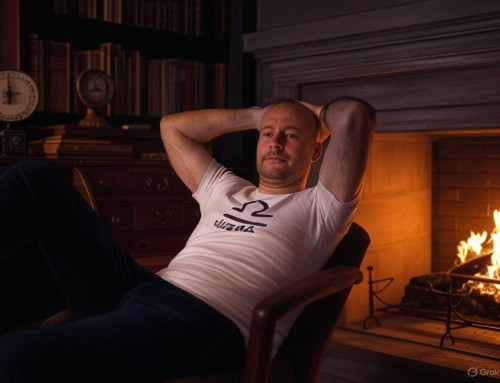How many people does it take to cut down a tree?
In August of 1976, American and South Korean soldiers posted up at the DMZ (demilitarized zone) that separates North and South Korea. A tree that North Koreans believed was planted by their leader, Kim Il Sung, was blocking the view between the observation post and a checkpoint. A decision was made to prune it back a bit to un-obstruct their view. Two soldiers, Captain Bonifas and Lieutenant Mark Barrett were tasked with doing the pruning.
The North Koreans, not understanding what the two men were doing, took it as an act of aggression, believing they were going to cut the tree down entirely. The North Koreans proceeded to bludgeon the two men to death when they didn’t stop and leave the tree immediately. This, obviously, did not sit well the allied forces.
The U.S. answer to the question, “how many people does it take to cut down a tree?” was as follows: Hundreds of American soldiers and Korean soldiers trained in Taekwondo, numerous Cobra Helicopters, Combat vehicles, B-52 Bombers – nuclear ready, and an aircraft carrier nearby ready to send off a fleet of fighter jets if needed. All to cut down a poplar tree. This was known as Operation Paul Bunyan.
This operation must have scared the bejesus out of the North Koreans as they let the operation happen without incident. This also led to the closest thing to an apology that North Korea has ever given since Korea split into North and South. This simple tree pruning nearly catapulted us into another war. All because of assumptions and miscommunication.
Have you ever talked to someone who trains in a specific martial art? Chances are, they had nothing but good things to say about their art form. And if asked about any gaps in their training in that art, they may suggest there are none. Yet, when asked about other arts they don’t train, they have a slew of attributes they feel “other” arts fail at. All while not seeing their own fails. It’s understandable that we take pride in what we do and feel there are not downsides. However, not seeing your own downfall while only seeing the negative in “others” can hold one back from truly accomplishing their goals.
It’s human nature to see the worst in “the others” while only seeing the positive in ourselves. Mentally, it would be quite destructive the other way around. It also helps us connect with likeminded individuals to build our group of trusted individuals who help us through life. That doesn’t mean we should be ignorant of our downfalls and never see benefits in others. This mindset leads to a lot of assumptions and misunderstandings, which in turn can lead to arguments.
Every martial art has something important to teach. I’ve trained, in some regard, in many of the major martial arts this world has to offer. I’ve “borrowed” techniques, drills, or ideas from every single one of them. In my own arts, there are holes or downsides as well. There’s just not enough time in a lifetime to fill every hole or cover every weakness in our arts. That doesn’t mean we need to hide it or lie to ourselves or others that those weaknesses don’t exist.
For a number of years, I have volunteered at a local middle school here in Wilmington, NC. The school, at the time, had a lot of financial troubles and was even shut down for a while until volunteers and outside donations helped build the school back up. Each student at the school was allowed to sign up for one enrichment program that was taught by a volunteer. Dance, yoga, gardening, soccer, basketball, film, and numerous other classes were available for the students to sign up for and attend during the enrichment hour(s). I, obviously, taught a martial arts class.
I always told the students I was teaching there, that I wouldn’t force them to practice if they didn’t want to, but that I would always ask why and try my best to convince them that training was a good idea. My goal wasn’t to train the next generation of ninjas, but to give the kids a taste of martial arts and to promote martial arts as an answer to the violence and hardships they may see around them. And that it could be way to make a living as well. Be it as a competitor or as an instructor. This is why I didn’t force them to train when they were having a bad day. I didn’t want them to associate martial arts with something negative.
Allowing them to sit out when needed also gave me an opportunity to ask about their day, which almost always provided a great discussion or learning opportunity. None more so than one day a few years ago when the entire class of fifteen students all sat down in silence and refused to train that day. Normally, it’s one kid here and one kid there that sits out. Though a vast majority of the time, all students participated knowing that it was their choice and they were not forced.
When I called for line up, none stood up. I asked what was going on. Silence, with all heads down. I told them that we didn’t need to train today, but we do need to talk. I asked one student in particular how his day is going. “How was your morning, James?”, I asked. “Fine”, he replied with his head still down. “How about after lunch?”, I continued. I could see James visibly not happy as he recalled his afternoon.
Rebecca, another student in the room, spoke up and stated, “Thomas threw a basketball at James face and made his nose bleed!” She continued, “the whole gym nearly got into a fight over it until the teachers got involved and moved everyone into different rooms”. “The teachers should have let us fight it out, as Thomas deserves to get his nose busted!”, shouted Timmy from the other side of the room.
At this point it was clear what was going on. James was hit in the face by a basketball that was supposedly thrown by Thomas. Half the room sides with James and thinks Thomas is a jerk who deserves a beat down. The other half of the room is defending Thomas as they believe it was an accident. No one wants to talk about it, only punch each other over it. Mind you, James and Thomas were friends before this. And everyone in the room had been quite friendly with each other until this point.
I asked Thomas what his side of the story was. According to Thomas, another student passed him the ball, but it was over his head. He threw his hands up to catch it, but the ball bounced off his hand and right into the nose of an unsuspecting James. All James knew was that the ball came from Thomas’ hands and assumed he had done it on purpose. James was too upset to hear the plea’s of Thomas that it was an accident. He was angry and hurt, and someone needed to be blamed and punished for it in his view.
After spending half of the class discussing the issue and coming up with alternate was of handling the situation, the issue was resolved. James’ nose still hurt, and he was still upset that he was hit in the face and felt embarrassed, but he now knew that Thomas didn’t do it on purpose, and it was truly an accident. It was a great learning opportunity for the students. Understanding that we can’t make assumptions, and that sometimes there is no one to blame for bad things happening. The kids returned to being friends, and the dark cloud that seemed to hang over the classroom dissipated as all students decided to join in class before time was up.
Life is hard. It seems to thoroughly enjoy hitting us below the belt as often as it can. We can’t stop all issues that life brings, but we can navigate how we act and react when bad things happen. Especially knowing there are two sides to every argument. Yes, many times one side is correct, and one side is wrong. That doesn’t mean the “wrong” side deserves being yelled at or talked down to. They aren’t purposefully incorrect.
It’s rare that we need a snap judgement based on assumptions to move forward. Yet, this seems to be our most used reaction. We assume the worst of others while assuming the best of ourselves. Refusing to accept that accidents happen, and fists need to fly before communication. Recognize the fact that we have all been wrong about something we’ve argued about in the past. Did you like it when you were talked down to and yelled at? I’m guessing not. The golden rule. Treat others the way you want to be treated. Well, unless you’re a masochist. Then let’s avoid arguments.
I have this conversation with my after-school students every school year while discussing one of the tenets of Taekwondo, self-control. In martial arts we spend most of our time on physical self- control. Learning how to punch accurately with efficient movement. Learning to balance in order to throw a well-timed kick. Even using joint locks and grappling techniques to control the opponent. Yet, we forget that physical control of the body isn’t the only form of self-control.
Emotional self-control is just as, if not more, important as physical self-control. Taking the time to stop and think through the situation and remain calm rather than quick to anger has kept me out of a startling number of physical fights in my lifetime. I see this lack of emotional self- control as one of the biggest issues I see, not just in my youth classes, but in society as a whole.
I’ll repeat the advice I give to my youth students for those who feel they may need it.
- First and foremost, understand that most situations don’t need immediate responses. Take a moment to breathe and truly comprehend the situation.
- Ask questions calmly for clarification. You may simply be misunderstanding the situation. I’ve been taken back by someone yelling at me. Only to discover they were
joking, or they were yelling at someone else. - Remain as calm as possible, but also prepare for the worst if communication breaks down. Don’t allow someone to get in your “red” zone. I label the area around you that someone can physically touch you as the red zone. This zone is for fighting and intimacy. Unless you think this person is about to kiss you (and you’re cool with that), take a step back. If needed, place your non-dominant arm on their chest to maintain space and place your dominant leg behind you. This gives you space to react in and gets your posture and feet in a ready position with as little escalation as possible. Note, do not raise your other fist as if you’re about to throw a punch. This can escalate the situation. Instead, hold it up with your hand open, palm facing the other person. This guards the face as well as gestures, “please step back/calm down” which can potentially de-escalate the situation.
- Use a firm and direct voice so that you don’t come across as someone that is weak, but don’t yell. Your goal is to bring the other person down to a rational and equal level. Not “under” them to please them or “over” them to make them feel weak.
- Don’t use negative words. Telling someone to “shut up” or calling them names will escalate a situation. On the flip side, don’t present yourself as “under” them by simply giving in to whatever they are saying and trying to be overly respectful. Place this person on the same pedestal as you. Talk to them like a sibling or friend that you respect. Talking down to someone, even calmly, escalates the situation. Talking up to someone as if they are better than you will not work well either and could lead you to lingering feelings of frustration and anger afterwards.
- Be ok with walking away. Every situation is different and walking away could save your life or may cause more problems. Talking things through calmly and truly understanding the situation can help you decide the best outcome. And many times, simply walking away and being ok with them getting the last word in can keep you out of harm’s way. If you do walk away, don’t turn you back to the person until there is plenty of distance.
- In the worst-case scenario where all communication breaks down, the physical will ensue. If you know and are good with joint locks or quick takedowns, and you know for a fact this situation is going to turn physical, initiate a controlling technique. Striking the person at this point is a possibility, but you must know that this person aims to do you serious harm or you may be in serious trouble as you’ll be seen as the attacker. Joint locks and controlled takedowns can quickly end the situation with no injuries and no jail time. Again, know the situation. If you can’t get away and this person is clearly reaching for a weapon, all bets are off. You need to act before they do and stop them any way you know how. Vital areas and nerve strikes have stopping power. Punching someone’s face rarely does.
Recognize that your overall objective is to not be waivered by their aggressive actions/words unless you know for a fact there is a true threat on your life. There are few things more powerful than staying calm in a chaotic situation.
The last step listed above is where all of your martial arts training comes in. Recognize there are numerous steps before we get to this point. A vast majority of these situations can be resolved before the physical ensues if you follow the steps listed above. For myself, all of my fights where punches were thrown, were done before I began my martial arts training. Once I learned how easily it is to get seriously injured and how easy it can be to seriously injure others, I found smarter ways to deal with conflict.
I’ve had to use joint locks a handful of times to control a situation. Not one punch was thrown, and no injuries occurred when I applied a joint lock. Surprisingly, most every time the other person didn’t even understand what had happened and why they were on the ground. This led to a confused look on their face and forgetting how angry they were and walking away.
Hopefully one day we can all learn emotional self-control and avoid World War III due to accidentally pruning the wrong tree.







Leave A Comment